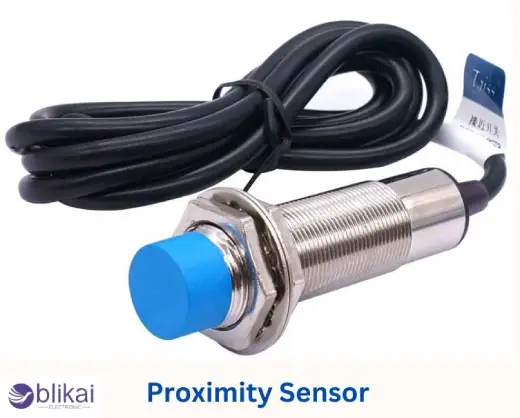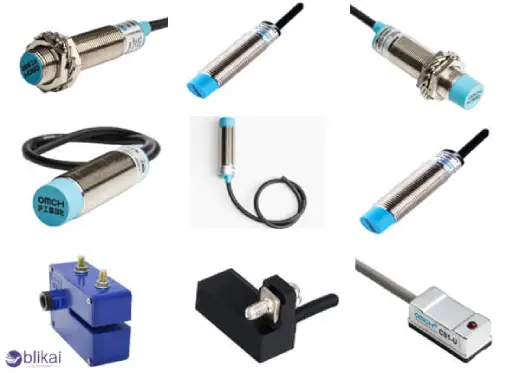Proximity Sensor: Types, Working Principle & Applications
Introduction to Proximity Sensors
A proximity sensor is an electronic part that is used to sense the presence or absence of an object within its sensing range with no physical contact. The usage of these sensors is vital in contemporary automation systems because of their high sensitivity; they respond very fast and are very resistant, and have a long life. Through proximity sensors, the industries can make processes automatic, more safe, and with less wear and tear of the mechanical parts, which was the case in traditional contact-based sensors.

How Proximity Sensors Work
Proximity sensors are sensors that detect objects by sending out a signal (electromagnetic, ultrasonic or optical) and observing its disturbance or reflection on an object entering the sensing field. How these sensors detect the objects varies depending on the type of sensor:
- Inductive sensors detect changes in magnetic fields caused by metallic targets.
- Capacitive sensors watch a variation in capacitance brought about by nearby substances (both metal and non-metal).
- Ultrasonic sensors determine the reflecting time of the sound of an object.
- Optical or photoelectric sensors consist of light rays to identify such interruptions or reflections that cause the object.
The signal is detected, decoded and converted to an electrical output, which is then used to move on to other functions, like running a motor, opening a gate, counting products on a conveyer, etc.
Major Types of Proximity Sensors
Inductive Proximity Sensors
These types of sensors detect only metallic objects. They are electromagnetic induction working devices. When a metallic object is brought into a magnetic field created by the sensor, it distorts the field and a response is created. They can be perfectly used in the industry where the detection of metal should take place, including the detection of metal pieces in gears.
Capacitive Proximity Sensors
The capacitive sensors sense metallic and non-metallic objects such as plastics, wood, and glass. So they work in a capacitance sensing mode of the target material. They can be used in such areas as fluid level sense, packaging lines (plastic) and the presence of objects.
Ultrasonic Proximity Sensors
Such sensors work with high-frequency sound waves in order to detect objects. The sensor sends out a sound wave and receives the positive. The distance where the object is located is shown by the interval that the echo takes to get back. Ultrasonic uses are ideal in distance measurement, detecting objects in dusty areas and sensing transparent objects.
Infrared (IR) Proximity Sensors
The usage of IR light occurs in the infrared sensors, which detect near objects. They send out the IR beam and pick up its reflection in an area. IR sensors have a very wide range of applications, including in smartphones (to turn the screen on/off), automatic faucets and simple obstacle detection in robotics.
Photoelectric Proximity Sensors
Photoelectric sensors detect objects with the help of a beam of light. They are of three kinds:
- Through-beam The transmitting and receiving devices are set 180 to each other; the object must disrupt the beam to be detected.
- Retroreflective: Both the emitter and the receiver are on one side and a reflector faces them. It becomes detected when the beam is disrupted.
- Diffuse: This sensor docks light reflected off of an object.
Magnetic Proximity Sensors
Magnetic sensors change according to magnetic fields, generally with reed switches or with Hall effect sensors. They are popular in industrial limit switches, and security systems like door/window open and closed detection.

Key Applications of Proximity Sensors
Industrial Automation
Proximity sensors underpin manufacturing vitality. They sense whether there are items on the assembly lines, lead the operation of the robotic arms and provide warnings to prevent collision or other errors in the operation of the machine.
Automotive Systems
Proximity sensors on cars provide parking support, detection of objects, automatic braking and seat belt warnings. Such sensors are essential for user satisfaction, as well as safety.
Consumer Electronics
Technologies of IR proximity sensors based on IR are employed in devices, such as smartphones and tablets, to switch off the screen when making a phone call. Proximity sensors are also used in home appliances, including touchless faucets, automatic soap dispensers, etc.
Medical Equipment
Proximity sensors in medical devices contribute to the detection of fluid levels, control of automated motions in devices used to treat patients and hygienic contactless work.
Smart Home and IoT Devices
The device finds use in proximity sensors powering lighting systems that turn on when an individual enters a room, automation of home security systems, and assists in energy-saving measures, especially in occupancy detection.
Security Systems
These sensors serve to detect unauthorized entry, windows or doors open, identify and monitor restricted areas without the need to touch them physically.
Advantages of Using Proximity Sensors
These proximity sensors have many benefits in industrial, commercial and consumer applications because they are unique in that they sense objects without physical contact.
High-Speed Response
Proximity sensors are very quick in detecting, which makes them well suited to high-speed automation and suchlike real-time monitoring applications. They are able to spot objects in milliseconds, whether on an assembly line that is moving fast or on the software that will help to automate a vehicle.
Reliable Operation in Dirty or Hazardous Conditions
And since they are independent of optical clarity and direct association, several proximity sensors stay accurate even in contaminated, greasy or explosive conditions. In food processing, chemical manufacturing and mining, this is of great concern.
Compact and Flexible Designs
Proximity sensors are offered in many sizes and form factors, from small surface-mount to large industrial versions. They are readily integrated into smaller systems or circuit boards and smaller embedded devices because of their small size.
Energy Efficiency
They mostly use very little power, particularly when not in use, as do proximity sensors. It is why they are very useful in battery-powered applications, Internet of Things devices and portable systems where energy efficiency is important.
Enhanced Safety and Automation
Proximity sensors are also important in accident prevention scenarios, such as using them in machinery safety, the doors of the elevator, and driverless vehicles. This depends on their reliability, whereby they operate safely without human intervention.
Long Service Life
Since no moving parts or contact wear exist in proximity sensors, this makes them last much longer in use than any mechanical substitute available. Various sensors may undertake millions of operations without deteriorating.
Easy Installation and Maintenance
The proximity sensors only require little calibration and are easy to install. In most models, plug-and-play comes with the PLCs, controllers or digital interfaces to simplify the system and shorten the installation process.
How to Choose the Right Proximity Sensor
Various factors determine the selection of the appropriate proximity sensor:
|
Selection Factor |
Description |
|
Sensing Range |
The distance from the sensor at which objects can be detected. |
|
Target Material |
Metallic, non-metallic, transparent, or liquid objects require different types. |
|
Environmental Conditions |
Consider temperature, moisture, dust, and vibration levels. |
|
Mounting & Size |
Compact sensors may be needed for tight spaces. |
|
Output Type |
Choose between analog, digital, NO (normally open), or NC (normally closed). |
|
Integration Options |
Compatibility with PLCs, microcontrollers, or control systems. |
Installation Tips and Best Practices
- Mount the sensor securely to prevent vibration-induced errors.
- Do not put sensors in the vicinity of excessive magnetic or electrical fields.
- EMI can be reduced by wiring properly and grounding.
- Set the sensor to the manufacturer specification.
- Prior to deployment, test the target range and the output.
Future Trends in Proximity Sensor Technology
- Sensor condensing to wearable and mini-devices.
- Intelligent sensors that have in-built microcontrollers to process.
- Bluetooth, Zigbee or Wi-Fi wireless integration.
- AI as an adaptive learning and predictive maintenance.
Conclusion
Proximity sensors play a role in the design of automation and intelligent machines. Their ability to detect objects without being in contact with humans has made their application absolutely imperative in many areas which include manufacturing, automobiles, smartphones, and home automation. Understanding which different types exist, how they operate, where they can be used, will allow engineers and systems designers to select the appropriate proximity sensor to match maximum performance and reliability.
Some images are sourced online. Please contact us for removal if any copyright concerns arise.
Piezoelectric Sensor: Types, Characteristics, and Applications
Types of Sensors: Comprehensive Guide to Sensor Varieties
Hall Effect Sensors: Types and Applications
What is a Vibration Sensor? Application, and its Types (2025)
What Is a Mass Air Flow Sensor
How to Fix an Oil Pressure Sensor?
Smart Sensors: Introduction, Features and and Applications
What is a Capacitive Sensor: Types and Applications (2024)
What is the DS18B20 Sensor? Everything Explained (2024)
Nanosensor: Types, Working and Applications (2024)










